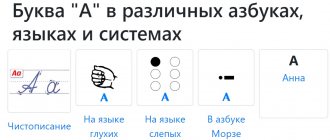1. Pronunciation of the sound [S] 2. The difference between the articulation of the sound [Z] and the sound [S] 3. Articulation of the sound [C] 4. Methods of setting the sounds [S], [Z], [C] step by step 4.1. Lip exercises 4.2. Gymnastics for the tongue 4.3. Breathing exercises 5. Second stage of production 6. Automation of sounds [S], [Z], [C]. Working with cards.
Work to eliminate the shortcomings of pronouncing the sounds [С], [З], [Ц] in most cases requires lengthy and painstaking actions. The teacher needs to clearly imagine the correct articulation of these sounds.
Pronouncing the sound [S]
- the lips slightly stretch into a smile, except in those cases when the subsequent phonemes are the vowels [O] and [U], which leads to anticipatory rounding of the lips;
- the teeth are either compressed or brought together, leaving only a narrow gap (about 1-2 mm);
- the tip of the tongue rests on the gums of the lower incisors, its back is curved, and the lateral edges are adjacent to the upper molars;
- along the tongue, in its middle, a groove is formed, which at the alveoli opens outwards with a narrow round hole;
- the soft palate is raised and closes the passage of air into the nasal cavity;
- The vocal cords are open and freely allow exhaled air to pass into the pharyngeal and oral cavities. The air stream is narrow, cold, strong.
Speech exercises to reinforce the pronunciation of the sound “C”
Pronouncing the hard sound “S” in straight syllables
1. Pronounce or read the syllables, extending the “s” sound:
- “sa-sa-sa”; “sy-sy-sy-sy”; “su-su-su-su”; “so-so-so-so.”
- “sa-sy-so-su”; “sy-so-su-sa”; “so-su-sa-sy”; “su-sa-sy-so.”
2. Game “Memorize and repeat”:
- “sa-sa-so”; "so-sa-so"; "so-sa-ea"; “sy-sa-sy”; “sa-sy-sy”; “sa-sy-sa”; “sa-sa-sy”; “sy-so-su”; “su-ey-su.”
3. Repeat the nursery rhyme and remember it:
- Sa-sa-sa - here comes the fox.
- So-so-so - she rolls the wheel.
- Sy-sy-sy - a fox has a red tail.
- Su-su-su - we are not afraid of the fox.
Pronouncing syllables
- “So”: juice, catfish, sleep, Sonya, soda, falcon, litter, hill, barefoot, oblique, sand, sock, forest, belt, spikelet, wheel, bean, tall, sedge.
- “Sa”: himself, garden, lard, sleigh, Sasha, sugar, cod, sleigh, wasp, fox, braid, dew, bite, write, beauty, sausage, stripe, sambo, landing, mustachioed, kindergarten, write.
- “Su”: soup, bough, court, bag, vessel, dishes, carry, draw, carry, vessel.
- “Sy”: cheese, son, owl, full, scales, mustache, noses, scarf, parcel, rash, mound.
Pronunciation of words
1.With unstressed syllables:
- Salad, gardens, boot, fireworks, cash register, mass, plane, sundress, Larisa, rat, be able to, chest, souvenir, cheese, son, raw, wasps, beads, rails, hair, blond, send.
At this stage, it is recommended to use visual material, card indexes of subject pictures, and playful work techniques.
2. Pronounce the syllables correctly:
- “ska-sko-sku-sky”; “sla-slo-slu-sly”; “sma-smo-smo-smy”;
- “swa-swo-swo-swa”; “spa-spo-spo-spa”; “hundred-hundred-stu-sty.”
3. Read or say “difficult” words - with a combination of consonants:
- Pile, dump, dump, your, firmament; rolling pin, roll down, tablecloth, bench, fast, Glory, sweet, elephant, word, hearing; could, we can, wash away, dare, sheaf, again, dreams; sleep, dispute, sport, satellite, confuse, camp, steel, put, put, old man, glass, get, stand up; one hundred, table, so much, stand; tincture; chair, knock, steps, offense, deed.
Methods for setting sounds [S], [Z], [C] step by step
As diverse as the defects in pronouncing the sounds [S], [Z], [Ts] are, the ways to overcome them are just as diverse. To produce whistling sounds, complex and precise movements of the tongue are required, which involve the tip of the tongue, the lateral edges of the tongue, and the back of the tongue. Also necessary are precise movements of the lips (in a smile), the lower jaw (barely lowered) and the presence of an air stream (sufficiently strong and moving in the middle of the tongue). To develop the necessary movements of the lips and tongue, a series of articulation exercises should be performed.
Lip exercises
"Smile"
. Smile so that the upper and lower teeth are visible, hold this position for 5-7 seconds.
"Tube"
. Extend lips with a tube:
1st option - pronounce the sound [U] for a long time without using your voice;
2nd option - pull your lips slightly forward, as if forming a square. The teeth are closed.
"Doors Open"
. Slowly open your mouth until there is a distance of 10-15 mm between the upper and lower teeth, hold your lips in the “Smile” position.
"Bunny"
. Smile so that your upper and lower teeth are visible, raise your upper lip (wrinkle your nose), and lower it back into place.
Lower your lower lip and open your lower teeth. Lips and teeth are closed. Repeat 5-7 times.
Gymnastics for the tongue
"Pancake"
. Place a wide, relaxed tongue on the lower lip.
Make sure that the lower lip does not tense. The upper teeth should be exposed (that is, the “Smile” position is maintained). If the tongue does not take the desired shape, it is recommended to do a passive massage, pronounce syllables with the tongue sticking out between the lips, for example “ba-ba-ba”.
Upon achieving success, make your tongue wide without pronouncing these syllables and blow with a narrow cold stream of air until a groove is formed along the midline of the tongue.
"Swing"
. Raise your wide tongue over your upper teeth and then lower it behind your lower teeth. Perform the exercise counting 8-10 times.
"Let's brush our teeth"
. Smile, show your teeth, open your mouth slightly and “clean” your lower teeth with the tip of your tongue, first moving your tongue from side to side, then from bottom to top.
"Slide"
. Smile, show your teeth, open your mouth, place the tip of your tongue behind your lower incisors, pushing the middle part of the back of your tongue forward (“built a slide”).
"Monkey"
. Bite the side edges of the tongue (perform the “Gorka” exercise) and, holding the tip of the tongue behind the lower teeth, bite the side edges of the tongue on the right and left (you can pronounce “ey-ey-ey”). If this doesn’t work, then pronounce the sound “i-i-i”, stretching your lips as much as possible and holding the tip of your tongue behind your lower teeth.
"Pussy is angry"
. Smile, show your teeth, open your mouth, place the tip of your tongue behind your lower incisors, arch your back and stroke it with your upper teeth. In this case, you need to make sure that the lower teeth do not move forward.
“High slide - low slide”
. Lower the tip of the tongue behind the lower teeth, pushing the middle part of the back of the tongue forward (“high slide”). Holding the tip of your tongue behind your teeth, pull the middle part of the back of your tongue deep into your mouth (“low slide”). Repeat 3-4 times.
Breathing exercises
"Breeze"
. Simply blow through closed lips, controlling the stream of exhaled air using a strip of paper brought to your mouth, a piece of cotton wool suspended on a thread, or simply by feeling the stream on your hand brought to your mouth.
"Put the ball into the goal"
. Stretch your lips forward with a tube and blow for a long time onto a cotton ball (lying on the table in front of the child), driving it between two cubes.
“Who will kick the ball further?”
Smile, place the wide front edge of the tongue on the lower lip, as if pronouncing the sound [F] for a long time, blow the cotton wool onto the opposite edge of the table. The lower lip should not be pulled over the lower teeth. Make sure that the child does not puff out his cheeks and pronounces the sound [F], not [X].
"Singing Bubble"
. The exercise is done in front of a mirror with the tongue stuck wide between the lips, its lateral edges adjacent to the corners of the mouth. A longitudinal groove should form in the middle of the tongue. Holding the vial (test tube) vertically, you should bring its hole to the middle part of the front edge of the tongue. If, at the moment of blowing, a groove is formed along the tongue, along which an air stream rushes, then when the bubble (test tube) is brought to the tongue, a strong noise should be heard, which indicates the correct alignment of the tongue.
"Focus"
. Smile, open your mouth slightly, place the wide front edge of your tongue on your upper lip so that its side edges are pressed and a groove is formed in the middle, and blow off the cotton wool placed on the tip of your nose. The air should go in the middle of the tongue, then the fleece will fly up.
Stage 2: selecting correction techniques
Correction depends on the shape of the defect. We will talk about universal techniques that can be used for staging in any case. These include imitation, the use of reference sounds and mechanical influence.
Imitation technique
Imitation training is effective for minor defects in sound pronunciation in children. Show your child how to pronounce the hard sound “s” correctly. To do this, sit both in front of the mirror so that he can see both himself and you. Next, give your child the following instructions:
- Open your mouth and smile.
- Spread the tongue, tense its tip and rest it on the lower teeth (incisors).
- Let the “breeze” pass through your tongue. The result should be "c".
Young children absorb information and master skills better through play. Come up with them for your child! For example, you can pump up a bicycle tire, deflate a balloon, blow into a bottle with a narrow neck, or blow like a sea breeze - all these actions are accompanied by the sound "sssssss."
Technique of staging from reference sounds
If the child pronounces other sounds well, you can build on them. In the case of sigmatism, the reference sounds are the soft “s” and the interdental “s”.
We use the soft sound “s”.
First, ask your son or daughter to pronounce the sound “s” and see where the tongue is located at this time - the correction depends on this.
- The tongue is located at the top - it rests on the incisors. You can teach your child the correct pronunciation of sounds. To do this, the adult opens his mouth and says “s”, the baby watches and repeats after him.
- The tongue is located below - rests on the teeth. The child is taught to pronounce “s” from the correct articulatory position - the tip of the tongue is on top.
When the baby has learned this, the skill needs to be finally consolidated. This is facilitated by staging exercises.
We pull the sound . The baby smiles and says “s” for a long time. At this time, he himself or the adult below puts his palm to his mouth. When making sounds, slightly cool air should flow.
Rounding the lips . Continuing to do the exercise and holding his palm to his mouth, the baby rounds his lips and pulls them into a tube, as if to pronounce “y”. An adult can show by example how this is done. The mouth should not be opened wide.
We monitor the air . The main condition is that the air flow must be continuous when performing all actions. Moreover, it gets warmer over time.
We reach a solid “c”. If the baby is unable to pronounce it automatically, the adult explains that the task now is to “warm up” the air in the palm. Then everything will work out.
We say "su" . This is an auxiliary exercise that will help your child achieve the desired hard “c”. We monitor the hot air.
We say a hard “s” . As soon as the result is obtained, show with your example: move your lips forward, as if you are going to say “y-y-y-y”, clench your teeth. This will “affirm” the “s” even more. If the baby presses his tongue tightly against his upper teeth, it will be even easier for him.
We consolidate the result. Introduce the learned sound in syllables with all vowels.
We start from the interdental reference sound “s”
Does the baby stick his tongue between his teeth, pronouncing “s”? Look where exactly the tongue is located:
- There is a “groove” along the tongue; the baby places the tongue between the teeth. Show your child how to hide it behind his teeth and say “s” yourself so that the baby can see;
- There is no “groove”, the tongue is flat. First of all, you need to establish correct interdental sound pronunciation. An adult should not say “c” out loud.
In this case, the following step-by-step production of the sound “s” is used.
Correct articulatory posture . The student needs to spread it out and stick it between his teeth. Move the tip of the tongue forward or position it at the level of the incisors. Then smile widely with closed lips and, ideally, bite the sides of the tongue.
We blow into our palms. The main thing is that the air stream should be as cold as possible. This will create the necessary “groove”. The baby should smile continuously; you can hold the upper lip with your finger - this will make it easier. If he does everything correctly, a whistling sound will be heard.
We whistle like a mosquito . Sit the baby in front of the mirror, show him the “groove” and explain that thanks to it the baby can whistle. But that’s how a big mosquito whistles, and you need to learn to speak like a small one - in a thin voice.
Finally we put “c”:
- The student continuously “whistles.” It is better if he controls this process by looking in the mirror. The main thing is that the “groove” must remain in place.
- Slowly removes the tongue behind the upper incisors and presses it against them from the inside. The adult shows how to do this, but does not say “s”.
- The baby almost achieves the correct sound pronunciation. Then he opens his mouth and the correct pronunciation is heard.
When the student correctly pronounces “s” in isolation, begin to introduce it into speech: first in syllables, then in words.
Mechanical impact
For setting, use counting sticks, blunted toothpicks, matches - any of the listed tools will do.
One of the ways is this. The baby places his wide tongue below, its tip resting on the lower incisors. An adult places a match in the middle of the tongue. After this, the child brings his palm to his mouth, bites the match and smoothly but forcefully blows out air so that he can feel it on the skin of his palm.
If “s” is heard at the same time, it is practiced with a match, and then without it.
Here are a few points to keep in mind when doing the “c” exercise:
First, insert the match into the baby’s mouth 2 cm, and if the tongue dodges, a little deeper.
Secondly, when pressed with a match, the little student begins to whistle with a “lisp.” Ask him to press his lips together so that only the match passes through, but do not let him bite it. The tongue remains in the mouth behind the teeth. The baby blows on the tip of his tongue so that the exhalation passes between the teeth.
Thirdly, control the pressure with the match. Try pressing harder or weaker, deeper or at the very tip of the tongue - this way you will find the position in which your child will get the perfect sound pronunciation.
Fourth, when you place the isolated “s” sound, begin to introduce it into speech. First - into syllables, and then into words. If the baby makes a mistake again when pronouncing the words, connect the match.
Engage with your child in the form of a game: draw analogies with cartoon characters, show pictures, interesting stories.
Stage 3: automation, or consolidation
Mastering correct sound pronunciation in isolation from speech is only the first stage of learning. Next, it is important to consolidate it and bring it to such automatism that the child correctly pronounces the new sound in words and phrases.
First work on the production in syllables, then in words, with “s” at the beginning, middle and end of words. After that, move on to proposals.
Second stage of production
If the child successfully copes with all the exercises, you can begin direct sound production.
The most common techniques for setting the sound [C] are the following:
- With your mouth slightly open, show the child in front of the mirror the difference between correct and defective articulation, and depict this using your hands. Having achieved the correct position of the tongue, you can turn on the exhalation and give the child the opportunity to feel the stream of exhaled air on the hand brought to the mouth.
- The sound [T] can be used as a basis for setting the sound [C], if it is pronounced correctly. You should ask the child to pronounce the sound [T] with some aspiration. The presence of aspiration should be controlled by feeling a stream of air on the hand. Then you need to invite the child to do the same, first resting the tip of the tongue on the gums of the lower incisors. Gradually, during the exercises, the fricative part of the continuous sound lengthens and then separates, after which it can be explained to the child that this is the correct sound [C].
- In more difficult cases (with lateral sigmatism), it is important to ensure that the air stream passes through the center of the tongue, so it is necessary to pay special attention to the exercises “Breeze” and “Who will kick the ball further?”.
- Having received the required result (the formation of a groove and the passage of a jet along it), we invite the child to raise his upper lip and blow. Gradually move the tongue to a position behind the lower teeth.
- Having lowered the tip of the tongue behind the lower incisors, the child should bite the lateral edges of the tongue and blow along the center of the tongue into the crack between the teeth.
The voiced sound [Z] is easily reproduced by simply adding the voice to the phoneme [S].
When automating the sounds [S], [Z], [C] in words, one should take into account the child’s articulatory abilities, his age, the ability to master semantics, and mastery of the syllabic structure of the word.
Staging by imitation
The easiest way to make the sound [C], which parents can use independently in teaching their child. It is better to perform the lesson in front of a mirror, showing the baby how to correctly position the tongue, lips and teeth during pronunciation. And then train [C] in a playful way, offering to demonstrate how the wind blows through a window, or how a tire is inflated, etc. In some cases, only this exercise is sufficient, but often it complements other methods of producing the sound [C].
Effective classes with a speech therapist starting with the letter C
A qualified speech therapist will not use methods that force a child to do something he does not want to do.
How does a sound production lesson work [C]
An experienced speech therapist's appointment consists of fun games, close to pampering, when a child, together with an adult, is allowed to make faces in front of the mirror and utter various funny syllables.
Individual lessons on audio automation [C]
Such exercises should be regular until the result is achieved. Mandatory exercises for the formation of the correct sound include a game of imitating the noise of a pump, a blizzard, or a deflating balloon.
In a family where adults take the trouble to communicate with the child once a day, not in a hurry, but thoughtfully, correcting the pronunciation they hear, the child will gradually begin to speak clearly in a natural environment. Care in the family, a healthy moral environment and an adequate assessment of abilities are the key to a successful and psychologically healthy child.
Note to parents
The sounds “ts”, “s”, “sh” can be made at home. In this case, responsibility for the outcome of the training falls on the shoulders of the parents. The following principles must be kept in mind:
- The load on the speech apparatus increases gradually. Otherwise, the baby will not be able to learn new information.
- During the exercises, it is recommended to make associations with the world of animals and insects. The sounds “s” and “z” are compared to the squeaking of a mosquito.
- It is necessary to allow the child to independently find a comfortable position for the organs of articulation to reproduce insulating sounds.
- If your child does the exercises without enthusiasm, it is better to stop exercising. This indicates that he is tired.
- Classes must be regular. The optimal frequency is 2-3 times a week. The duration depends on the nature of the baby’s speech deviation.
- When performing mechanical production of sound pronunciation, objects that are not dangerous to the child should be used. It is desirable that this be a special speech therapy probe.
Preparatory activities
Before performing exercises aimed at developing conversational speech, breathing training is carried out. She teaches how to blow a stream of air from the lungs. To make the training more interesting for the child, it is recommended to use a small cotton wool or ball.
The most common exercises that develop breathing include the following tasks:
- It is necessary to prepare an empty small bottle. Its neck should be brought to the lower lip. A stream of air is directed into the bubble. If the baby does everything correctly, a characteristic sound appears. This exercise is called “storm”.
- The palms need to be placed on the stomach. Then a deep breath is taken through the nose, after which the breath is held for a couple of seconds. Exit is through the mouth. The purpose of the exercise is to teach the child to control the air stream. The task is called "accordion".
- The “breeze” exercise is performed by stretching out the lips with a tube. A deep breath is taken through the nose. Then a palm is placed to the lips, and a stream of air is released through the mouth.









